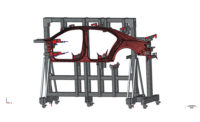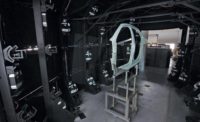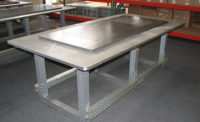On a cold, windy night about half past midnight you’re cruising down a lonely highway and check your rearview mirror. That hulking vehicle is gaining on you. You instinctively move over and let the eighteen-wheeler pass you by because he owns the road and we all know it. Where and how do they make those beasts anyway? Well, all over the world and the long haul trucking or “Over the Road” (OTR) vehicle industry is no stranger to implementing modular tooling for their fixturing needs, especially in America.
They even make tow trucks to tow those monsters. And when a base vehicle needs a drastic modification the reusability and reconfigurable fixturing with modular tooling products on the market today just keep getting better and with ease. When the big rigs require multiple part inspection naturally the modular componentry needs to be more robust in dimension and strength.
Enter a larger structural modular framing component and connection elements and a profile with a thicker wall of high tensile strength aluminum. Preferably, of the 7000 series material with a hard coat anodize surface throughout. This larger profile will afford best practice fixturing for those massive parts. For example, a fuel tank measuring large diameters in feet not inches. These tubular parts are often heavy metal structural forms of welded steel bodies maybe stainless. Imagine the twin tall exhaust “pipes” on either side of the cab or tanks mounted on board flatbed trailers hauling liquid on a 54’ rig. Materials vary. Molded heavy duty plastics containers (an updated material design feature to transport large capacity fuel or milk) enables considerable weight savings when loaded with less fuel consumption by the cab. On the smaller scale, think window washer fluid reservoir. The tubular, cylindrical or round part has always been a challenge for fixturing but with the right holding clamps and locating elements it’s a snap.
Presenting these parts to the CMM for inspection can and will be tricky. Unlike a small car door, fender, hood and more, all the cab, or body parts for exterior and interior in these large scale vehicles are checked with similar processes. New designs for this challenge and to accommodate change in design for workholding is a key reason to look to modular systems. Even the latest tech will bring electric vehicles (EV) to these big rig manufacturers. There has been a continuous drive (no pun intended) to roll with the necessary changes for massive batteries, storage and charging componentry. It’s inevitable that this technology is upon us and the freight vehicle makers are responding. The short haul and long haul requirements are growing and EV will be a major force for the local delivery trucking industry. Online shopping has been a target for these vehicles, especially over the last year with more shopping and delivery options during the global lockdowns.
The parts list is massive on any vehicle and almost every part is inspected in this industry. When the inspection team needs to zig left or right to get a rack of parts to the assembly line for production they need to act quickly. The last thing they want is to stop production because the part problem down the hall is in fixturing and not a lack of parts from an outside supply chain.
Management has been making the call to keep things rolling (sorry, another pun). Empowering their human element with the tools they need to get the job done has never been more critical. Budgetary, finance or plain old ROI (return on investment) is eminent. The “kit” concept vs. dedicated fixtures is the way they go more and more. The solution is simple whether it’s a backup plan or procedural because the value is obvious. It saves time and money hands down. Get your kids some functional interactive toys and watch that bottom line improve.
Having the right components is a learning process. Sort of like calories in, calories out: more parts, more components and more options. Sizing up your “family” of parts takes time but there is no shelf life issue with modular tooling. I always say, “It’s like a toy box that never gets old or goes out of favor.” It just keeps improving not unlike the end product coming off the production line.
During the pandemic, distancing and masking created new challenges and ever persistent, as of this writing, we have had to make decisions on the fly daily, weekly, if not hourly to move forward in all facets of communication and manpower. Whether it be staffing or outside sources, the need to zig when you can’t zag, the various teams in manufacturing have had to focus. “I came into the plant and due to part shortages we had to stay busy and get the job done. Because I had modular tooling already in service, I could whip up a fixture and get it done while waiting for parts so we could reopen production when part shortages were over,” said one large ORV manufacturing inspection manager in Texas. He had the right tools for the job and got it done.
As an example, a design fixture built for a rocket engine component was special but had many reusable modular tooling components. Next to zero waste. This complex tool was for a very large diameter tubular component. This manufacturer was also under the gun to build and change tooling to meet critical deadlines. The beauty was that the part (CAD) files were changing rapidly and the connecting tubular sections, with flange mounting assemblies, were also changing and not always in sync. This team was able to make adjustments on site by removing the special machined holding “nets,” make updates and easily replace with the simple locking and clamping devices.
These types of projects can get time sensitive if not “Code Red” critical. End customers for the final product on a contract basis just can’t wait, so it’s a team effort. Limiting the finger pointing with this type of solution made everyone come up for air and made it happen. Not so easy with a traditional, dedicated fixture that would require all of the processes of making a change—not on the fly by any means. That project was for aerospace rocketry in the late ‘90s and could still be in re-use today.
The point is that this technology is here to stay and just getting better and better. The new breed of inspection teams are truly learning how to implement systems in a multitude of ways. From parts large and small, metallic or plastics, it’s all suitable. Unless a part or assembly is so heavy that the systems on the market today just can’t withstand the structural mass, then looking into modular tooling with training and cross training members in engineering, the tooling rooms and inspection rooms, at all levels, will afford solutions with time and cost savings front and center. The guys upstairs are still happy.
Yes, there will be times when the old school welded, normalized, painted, yada yada the heavy construction welded fixture probably works best. There will be limitations. By comparison, over the years with technological ideas shared in the fixturing industry, the choices are now endless. Using process of elimination and discussing what works and what doesn’t opens up the conversation. New tech vs. old tech will never end so just “be creative, think modular” and keep on keepin’ on.






